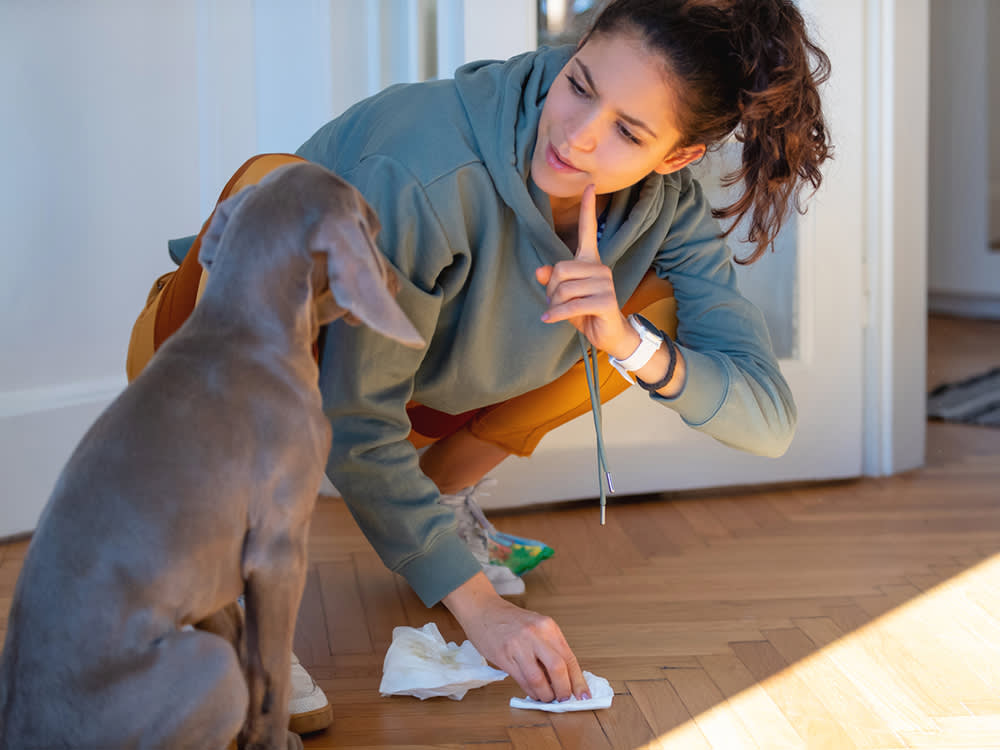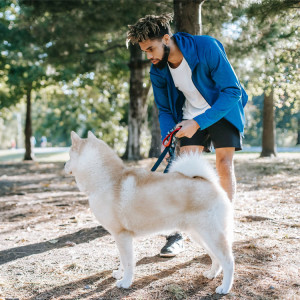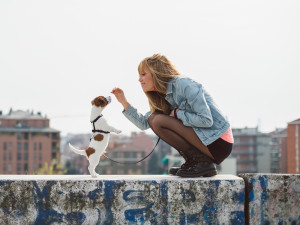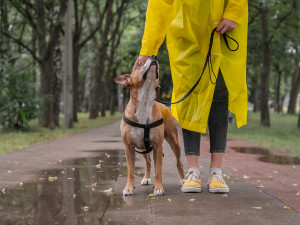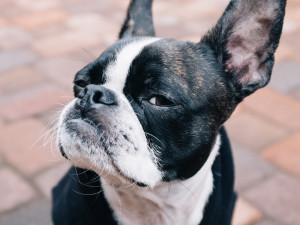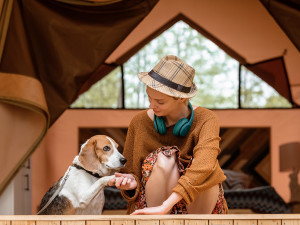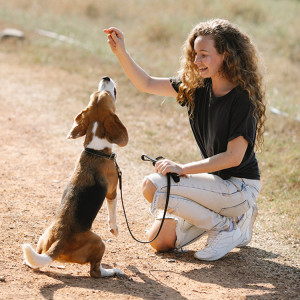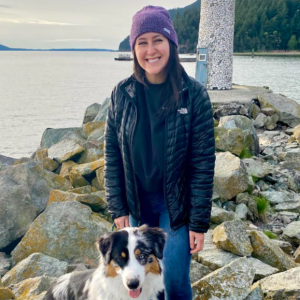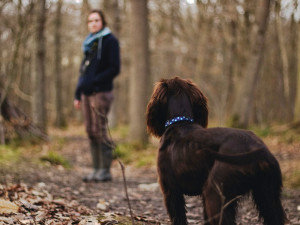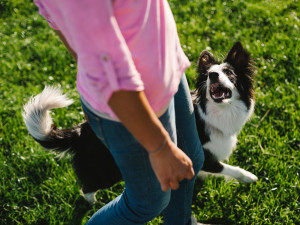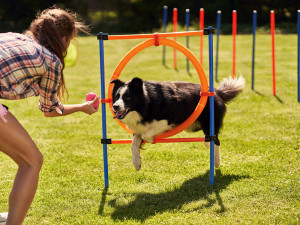10 Dog-Training Habits You Should Drop Right Now
Training a dog can seem pretty intuitive — until it’s not.
Training a dog can seem pretty intuitive: Reward them when they do what you want; withhold said reward when they don’t. But in case you needed a reminder, dogs aren’t humans, which means our brains don’t always understand theirs.
Case in point: “People often make everyday mistakes that either confuse their dog, encourage poor behavior, or otherwise undo their training progress,” Kim Roche, certified dog trainer and behavior consultant in Austin, Texas, says. Most dogs pay better attention than you think, she says, and at the end of the day, even the most rambunctious dog wants to do right by you — but trouble ensues when they don’t know how.
Of course, being 100 percent intentional with every little move you make around your dog is near impossible. But just being aware of the following common mistakes can make a huge difference in their manners — a win-win for you and your ready-to-please pup.
Calling Them Over and Over
No shame if you’ve had to shout for your dog repeatedly at the dog park or on the beach. Recall — calling your dog’s name when they’re off-leash so that they come back to you—can be super challenging to teach. But it’s also probably the most important part of training, says Jamie Hansen, an Aussie dog trainer and breeder in La Center, Washington, because it involves your dog’s (and potentially other dogs’) safety.
How much do you spend on your pet per year?
Let’s say you call for your dog eight times before they show up at your feet. That’s bad, says Hansen, because instead of responding to their name, your dog has now associated your calls as background noise. “You want them to turn their head and come to you on the first call, or second if they’re really distracted,” she says.
To train this behavior, Hansen recommends attaching your dog to a leash or line outside where they can run to a certain point. Bring the extra-yummy treats and call them: As soon as they turn their head to look at you, throw them a treat — and keep doing that, throwing treats on alternate sides of you. This teaches them to stop whatever they’re doing (no matter how exciting that squirrel or tiny Chihuahua might be) and pay attention to you. Try it at least three times a week for a couple of weeks and you’ll see a huge difference in their response, says Hansen — from there, you can start to work on the behavior in safe off-leash areas.
Using Only One Reinforcer
OK, we just told you to use treats for recall. But for smaller good-pup behaviors, you’ll want to think outside the biscuit box. “If you rely solely on treats to reinforce positive behaviors all the time, at some point, the excitement of the reward fades a bit,” Roche says. And if you run out of treats or forget to bring them? You’re SOL.
Your move: Mix up your reward toolbox, using other pleasurable incentives for everyday good behaviors (like sitting when you ask them to). Pet your dog on the head, give a belly rub, play with them, throw the ball — “any mix of things they love will cultivate a very stable dog that is able to work without food,” says Roche.
Giving Treats at the Wrong Time
More on treats! (Because they’re so key to a dog’s feedback loop.) “Dogs are self-important, which means that they’re looking out for their own needs and will manipulate us to meet them,” Hansen says. If you reward your dog in a moment when they don’t deserve the reward — say, they finally lie down after you asked them to 14 times — you’re reinforcing that they get a treat when they do things on their timetable.
Use “good girl” or “good boy” when they’ve listened after a while — if you’ve done even basic training work, they’ll know that if they do things better/faster, they can get a treat with this behavior. Similar to the recall thing, save treats for only when they’ve listened on the first or second command.
Going on Autopilot on Walks
We know, we know: Sometimes the only time you have to make that important call or vent to a friend or brainstorm for work is on your daily walks with your dog. But try not to. “We’re all human, which means we are absolutely going to overlook instances of good behavior sometimes,” says Roche. “But if we habitually do that, there’s really no difference to your dog between a behavior going unreinforced because we forgot to applaud it or because we don’t want them to do it anymore.”
Make a point to reinforce as many positive behaviors your dog does as possible in real time, including the spontaneous ones. Remember, they don’t go autopilot on you (just one more reason we don’t deserve them).
Shushing Them
Picture this: Your dog starts barking when the Amazon guy delivers the harness you ordered. It’s natural to try to quiet them with a “shhhhhh,” the way you would a crying baby, but again, dogs aren’t crying babies. “Energy feeds energy, and the ‘shh’ sound can sound like a small critter or the sound of running through grass,” says Hansen. “What they hear is: ‘more energy! — the opposite of what you want.”
Instead, use a cue word or phrase consistently, like “it’s OK,” or “calm,” in a lower-tone, soothing voice, Hansen recommends. In time, they’ll learn to match your energy.
Saying “Down” When Inappropriate
Trainers generally use the word “down” to teach a dog to lie down on the ground. If you’re using it for anything but — like, to tell them to get down from the couch, or to go back to their spot in the car — you’re creating a miscommunication, Roche adds.
Try your best to save “down” for when you actually mean lie down. Say “off” when you need them to get off of something (be it furniture, a person or another dog). The goal is to be extremely explicit with each command, says Roche — your dog will do what you say, so make sure you’re saying what you mean.
Not Using Hand Signals
On that note, dogs flourish with multiple cues for the same behavior, says Roche. Using one word alone can work for many instances, but you’ll increase your dog’s chances of listening success if they can understand you with their ears and eyes, she explains. (Also, if you’re ever in a loud or busy environment, or your dog ever goes deaf …you’ll be glad you started this.)
Pair your most-used commands with a gesture that matches, recommends Roche, such as pointing down with “sit,” flexing your hand like a stop sign with “stay,” and pushing air away with “off.”
Not Being Direct
Especially with puppies or a rescue dog that’s new to your home, you want to give them actual instructions. “Imagine you have a toddler getting into things: You could never just say, ‘Stop doing everything and just do nothing,’ notes Roche. “But you could say, ‘Go to your bed and lie down.’” Dogs are the same way.
Next time you want your dog to just chill TF out, be super specific with your instructions (that may mean showing them the behavior yourself, by going to their bed) and/or give them a project (like a rubber toy stuffed with kibble) to occupy them. It works!
Expecting Too Much
Oof, this one can manifest in so many ways. “Dogs are often smarter than we think, but we have to remember that they learn from us,” says Hansen. In other words, we can’t just assume they understand what to do just because it makes sense to us.
A prime example: You tell your dog to stay, then you walk away from them to test them and they break their stay. “We have to train them to understand the word, and to make that happen, you would wait for a second and give them a cookie before they get up, not after,” says Hansen. “You want to reward the staying put, not the getting up part.” Once they get a hang of this, then you can start to walk away, or dance, or do whatever you want as they sit there expectantly until you release them. Same goes for any trick or basic behavior — patience is key.
Missing Chances for Training Advancement
If you want your dog to be good all of the time (or let’s be real, most of the time), you have to teach them to be good all of the time. And that means making the most of even mundane moments, like feedings, to encourage wanted behaviors, says Hansen.
Have your dog sit before you give them dinner. Continue their walk only when they’ve stopped acting out. Make them work for every treat you give. Rub their belly (if they like that) when they stay by your feet instead of climbing on the couch next to you. “You don’t need every training lesson to be an hour,” says Hansen. “Every minute of interaction counts.”
